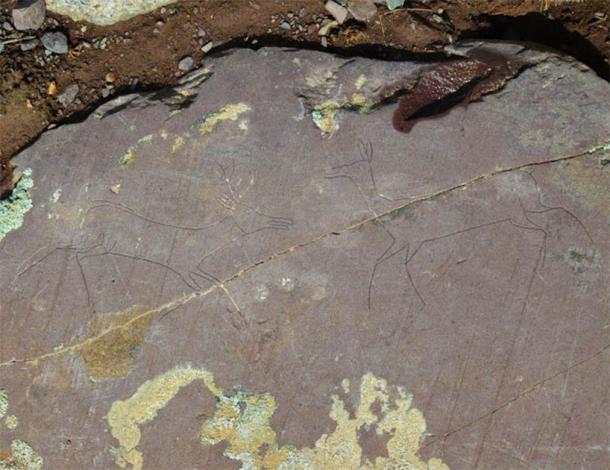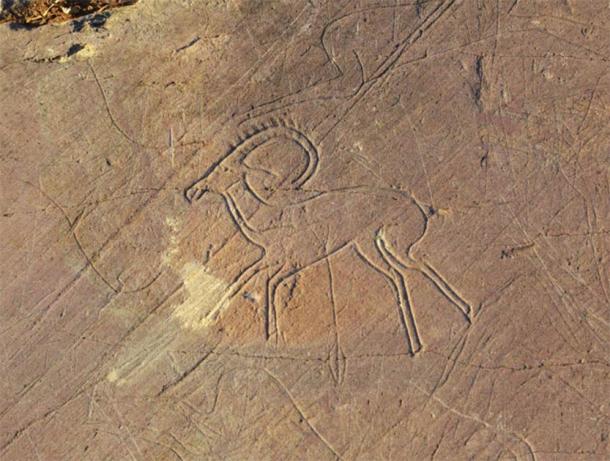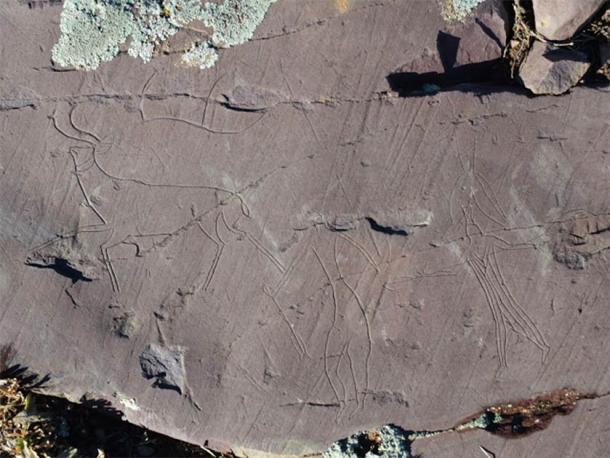Researchers in Serbia have studied a collection of ancient petroglyphs revealing the relationship between a medieval nomadic culture and animals. The team of researchers from the Gorno-Altaisk State University has published a new paper in the scientific journal Archaeology, Ethnography and Anthropology of Eurasia presenting their study of medieval Altai rock art, located near the famous Pazyryk burial mounds. Carved in shallow lines with pointed tools, the Altai rock art artisans created images of people holding different weapons in hunting scenes, and even ancient dwellings.
The Pazyryk burials are Scythian (Saka) Iron Age tombs located in the in Ulazhonsky District of the Pazyryk Valley, in the Altai Mountains of Siberia, close to the border with China, Kazakhstan and Mongolia. Dating to the 4th–3rd centuries BC these “Scythian-type kurgans tombs” are barrow-like mounds with internal wooden chambers covered by large cairns of boulders. It was in these ancient burial vaults that the Altai rock art was created and left behind for others to understand.

Many of the images found in Altai rock art related to deer-like animals. ( Gorno-Altaisk State University )
Altai Rock Art Depicts Ancient Animal Traditions
The most famous undisturbed Pazyryk burial ever recovered was the famous 1993 discovery of the “ Ice Maiden ” or “Altai Lady.” She was buried with six horses, in a ceremonial burial in a wooden chamber tomb in the fifth century BC. On the outside of her hollowed-out tree trunk coffin, which was made of a Siberian larch tree, were stylized images of deer and snow leopards . The new Altai rock art carvings, while much more recent, follow this traditional reverence of animals.
The monument was first examined by Kemerovo archaeologist A.S. Vasyutin back in 1980. At that time it was determined that the petroglyphs dated from the Early Middle Ages (Turkic era), with one older image depicting a chariot from the Late Bronze Age (2nd – 1st millennium BC). But it is only now, with new imaging technologies, that researchers have been able to study the ancient Altai rock art in totality.

This Altai rock art image is stunningly clear. ( Gorno-Altaisk State University )
Special Tech Used To Photograph The Altai Rock Art
While the area covered by the Altai rock art is expansive, each of the individual rock carvings at this site are quite small. And they were carved so long ago that the lines defining the images are very faint. One of the reasons it has taken three decades to study these images is because safe, non-invasive techniques have not, until now, been available. However, with a range of different digital photography and 3D imaging techniques the researchers have completed a full forensic study of the artwork at this site.
According to an article in Archaeology News Network the ancient petroglyphs were photographed under “lateral lighting” conditions, in the morning and evening when the sun was low above the horizon. This meant the faint lines of the carvings, which virtually vanish in direct sunlight, cast shadows. Under these improved lighting conditions, the researchers were able to take high resolution photographs. Each of the images was then enlarged on graphic tablets and magnified, revealing even the most timeworn details. With these enhanced images the scientists were able to determine what the ancient artisans intended their shapes to represent.

Two hunters with weapons hunting big game. ( Gorno-Altaisk State University )
A Visual Journal Of The Ancient Altai Nomads
Most images date to the Early Middle Ages and their motifs and themes have numerous parallels in Central Asian art. There are hunting scenes, armed fighting men, and pictures of bows and quivers which relate to a cult of weapons and militarism . Two warriors are shown holding spears with banners surrounded by mountain goats, reindeer, and boars. Some motifs even show ancient dwellings that look like “ yurts.” In another image a pair of male and female Siberian stags are running at each other and this has been associated with a fertility cult.
Read together, the ancient Altai rock art speaks of warriors, hunting scenes and weapons, and echoes of a violent, warring people who lived at the intersection of several ancient nations. But ultimately, the new study is a further volume in our understanding of life in the incredible Altai region , which the new study says “guards huge layers of life – sustaining activities of human civilization.”
Why this region is so important, historically, is because it is a place of “formation and cultural evolution” of ethnic groups that are today scattered across Eurasia.
Top image: Much of the Altai rock art revealed images of hunters and animals. Source: Gorno-Altaisk State University
By Ashley Cowie
 RSS Feed
RSS Feed















 December 2nd, 2020
December 2nd, 2020  Awake Goy
Awake Goy  Posted in
Posted in  Tags:
Tags: 













